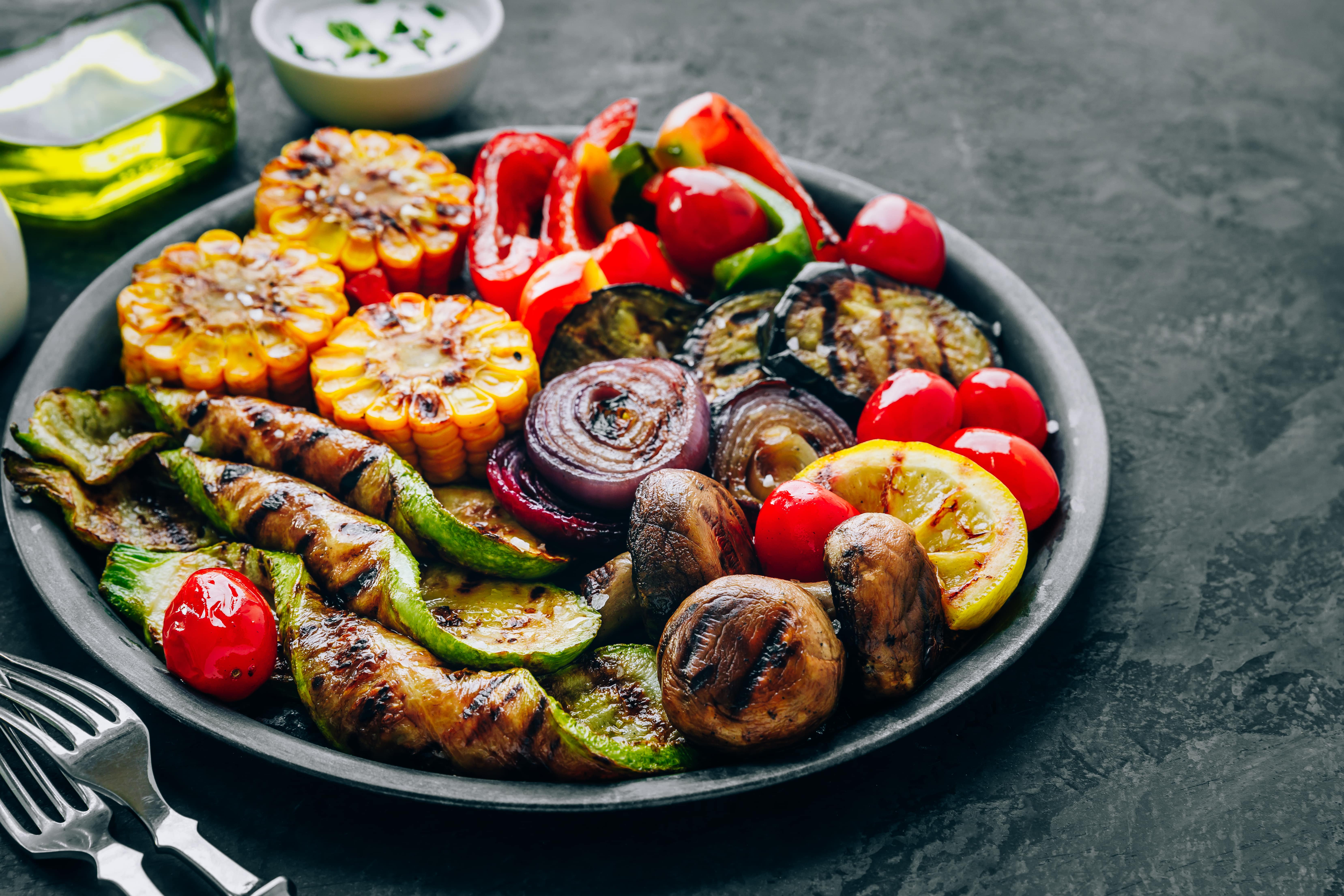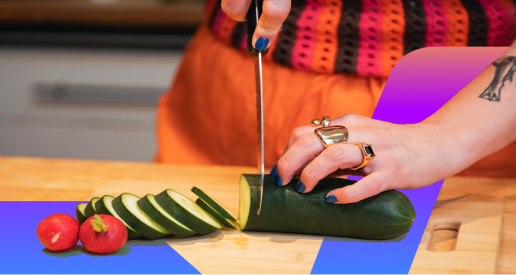Key Takeaways
- Grilled proteins, such as chicken, fish, and tofu, are naturally low in carbohydrates and help maintain steady blood sugar levels when paired with fiber-rich carbohydrates.
- Store-bought marinades and sauces can be high in added sugars, but making your own with fresh ingredients, such as spices, herbs, oil, and vinegars, is quick, easy, and flavorful.
{{mid-cta}}
With grilling season in full swing, the abundance of marinades, sauces, and side dishes may have you concerned about spiking blood sugar levels. The right mix of lean proteins, low-glycemic marinades, and fiber-rich sides will keep your blood glucose steady and leave you feeling satisfied. Whether you’re tossing a chicken on the grill or skewering some steak and veggie kabobs, these simple carb-smart choices will help you eat well and feel your best.
Protein Picks for Stable Glucose

Grilled proteins are the star of any good summer BBQ, and thankfully, you don’t have to worry about your protein choice spiking your blood sugar. In one study, a high (40%) or normal protein (21%) diet both resulted in comparable levels of reduced fat mass, A1C, glucose, insulin resistance, and additional biomarkers among adults with type 2 diabetes.1
Aim for lean, high-quality proteins like these:
- Skinless chicken breast or thighs: A lean, high-protein option that supports blood sugar balance without extra fat or carbs.
- Fish and seafood: Shrimp, tilapia, and salmon are light, quick-cooking, and rich in healthy fats that have a minimal impact on glucose levels.
- Tofu or plant-protein skewers: A fiber-rich, low-glycemic choice that’s the perfect grilling option for plant-based eaters and holds up well on the grill.
- Bean-based burgers: If you’re looking for a healthier alternative to beef, bean-based burgers are high in fiber and protein and hold up well on the grill. They will contribute a higher amount of carbohydrates than animal protein, but are slow-digesting and still a good option.
Sugar‑Free & Low‑GI Marinades

Store-bought marinades and sauces can be a sneaky source of added sugar, which could lead to unwanted blood glucose spikes. If you want to use a store-bought marinade for grilling, consider brands like Primal Kitchen, G. Hughes, and Walden Farms, which offer a variety of low-sugar and sugar-free options.
But, making your own marinade at home can be simple and quick, and is often cheaper, fresher, and more flavorful. All you need are a few staples, such as spices, seasonings, herbs, fruit, coconut aminos, and a few other whole and nutrient-rich ingredients.
You can easily mix and match spices, herbs, vinegar, oil, yogurt, and citrus to infuse flavor and tenderize proteins. Here are a few ideas to get you started:
- Coconut aminos and fresh ginger: Coconut aminos are similar to soy sauce but often have significantly less sodium. Combine it with freshly minced ginger for a warm and zesty kick that’s perfect for chicken, shrimp, or tofu.
- Citrus herb marinade: Mix olive oil, lemon or lime juice, garlic, and chopped herbs like parsley or thyme. Since this marinade has citrus, you’ll want to limit marinating time to 30 minutes for seafood and 4 hours for meat.
- Indian-inspired spice rub: Combine dried turmeric, cumin, garlic powder, and chili powder for a warm, dry spice rub. If you want a little sweetness without the sugar, add a bit of cinnamon to the mix.
- Yogurt-based marinade: Mix plain yogurt with herbs and garlic to tenderize the meat and add a fresh, cooling flavor.
- Smoky paprika and lime: Combine smoked paprika with lime juice, garlic, and olive oil for a bold smoky twist that’s great on everything from fish to veggies.
Sides That Support Glucose Balance

Most grilled proteins are naturally blood sugar-friendly, but what you serve with them can make all the difference. Carb-heavy sides like rolls, macaroni salad, or baked potatoes can cause your blood sugar to rise higher than you’d like, especially if eaten in a larger portion or all together. Choosing fiber-rich, non-starchy side dishes that help slow down digestion and maintain stable blood sugar levels is key. Thankfully, there are plenty of delicious and lower-carb side dishes that go perfectly with any BBQ.
- Grilled vegetable medley: Customize your veggie dish with any combination of zucchini, bell peppers, mushrooms, eggplant, or other non-starchy vegetables. Chop them into 1 to 2-inch pieces and thread them onto skewers or in a grill-friendly pan. They’re full of fiber, easy to season, and burst with flavor when grilled.
- Leafy green salads: Toss a big handful of greens with a simple olive oil or vinegar-based dressing for a bit of crunch, volume, and blood sugar support.
- Greek yogurt coleslaw or tzatziki: Whether store-bought or homemade, these creamy, protein-rich sides are low in carbs and provide a refreshing, cooling contrast to smoky grilled foods.
- Cauliflower rice or grilled portobello “buns”: These are great low-carb alternatives to bread or heavier starches that still feel satisfyingly hearty. You can even mix cauliflower rice with regular rice for a lower-carb, but still satisfying option.
- Avocado cucumber salad: The healthy fats from avocado help slow down digestion, making you feel more full and satisfied, while the creamy, cool cucumber is perfect for a refreshing summer side.
These sides don’t just support stable glucose; they also make your plate more colorful, flavorful, and satisfying. You can easily mix and match based on what sounds good and what’s in season.
Smart Grilling Tips for Blood Sugar Control
If you’re already a master on the grill, you don’t have to overhaul your entire routine and recipe collection to make a big difference in your blood sugars. A few small tweaks can go a long way in supporting stable glucose levels and your overall health, without sucking the joy out of BBQ season.
- Skip sugary sauces and rubs: Many bottled BBQ sauces and spice blends are loaded with added sugars that add up quickly and lead to blood sugar spikes. Try dry rubs with herbs and spices, or opt for sugar-free marinades instead.
- Be mindful of portions: Serving smaller portions can allow you to enjoy more of the foods you love without overeating. Keep your protein to 3 to 4 ounces and fill the rest of your plate with non-starchy vegetables or fiber-rich sides. If you’re enjoying dessert with your meal, keep the portion small and pair it with your protein for a smaller impact on your blood sugar.
- Use healthier grilling techniques: Stick to medium heat to avoid burning or charring, and lightly brush foods with oil to prevent sticking without adding excessive fat and calories.
- Pay attention to your glucose levels: If you use a continuous glucose monitor (CGM), check your levels before and after the meal to see how different foods or marinades affect you.
4 Seasonal Recipe Ideas to Try

While you can likely adapt many of your favorite recipes to support your goals, you can also try some of these fresh and flavorful low-glycemic recipes:
Citrus herb grilled chicken skewers
Cut skinless chicken breasts or thighs into bite-sized chunks and marinate them with a mixture of olive oil, lemon juice, garlic, and chopped herbs like parsley and thyme. Let them sit for 15 minutes. Skewer the marinated chicken and grill over medium heat for 10 to 12 minutes, turning halfway.
Ginger-coconut shrimp skewers
Combine coconut aminos, grated ginger, garlic, and a splash of lime juice. Marinate peeled shrimp for 15 to 30 minutes, then thread onto the skewers. Grill for 2 to 3 minutes per side until the shrimp are opaque.
Yogurt-herb marinated veggie skewers
Mix plain Greek yogurt with garlic, lemon juice, and chopped fresh herbs (try a combination of parsley, mint, thyme, and/or oregano). Toss with chopped veggies like zucchini, mushrooms, and bell peppers. Let sit for 20 to 30 minutes, then thread onto skewers and grill for about 10 minutes, turning occasionally.
Grilled portobello burgers with avocado spread
Brush portobello mushroom caps with olive oil and balsamic vinegar. Grill gill-side down for 4 to 5 minutes per side. Meanwhile, mash avocado with lemon juice, salt, and garlic. Serve the grilled mushrooms topped with the spread on their own or in a lettuce wrap.
The Bottom Line
Grilling season doesn’t have to be off the table when you're focused on balanced blood sugar. By choosing lean proteins, skipping sugary sauces, and loading your plate with veggie-packed sides, you can enjoy a satisfying meal that supports your health and still tastes like summer.
Learn More With Signos’ Expert Advice
Eating for better blood sugar doesn’t mean giving up your favorite foods. With Signos, you can make smarter, personalized choices based on how your body and blood glucose levels respond to what you eat.
Topics discussed in this article:
References
1. Clina JG, Sayer RD, Pan Z, et al. High‐ and normal‐protein diets improve body composition and glucose control in adults with type 2 diabetes: a randomized trial. Obesity. 2023;31(8):2021-2030. doi:10.1002/oby.23815




.svg)








.jpg)

.svg)
.svg)
.svg)
.svg)
.svg)
.svg)
.svg)
